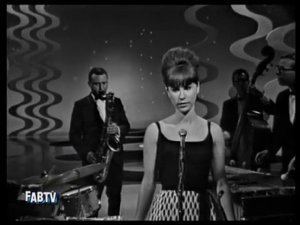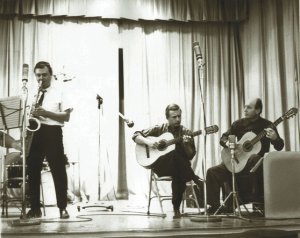
Águas de Marco – Elis Regina & Tom Jobim
É o pau, é a pedra, é o fim do caminho
É um resto de toco, é um pouco sozinho
É um caco de vidro, é a vida, é o sol
É a noite, é a morte, é um laço, é o anzol
É peroba no campo, é o nó da madeira
Caingá candeia, é o matita-pereira
É madeira de vento, tombo da ribanceira
É o mistério profundo, é o queira ou não queira
É o vento ventando, é o fim da ladeira,
É a viga, é o vão, festa da cumeeira
É a chuva chovendo, é a conversa ribeira
Das águas de março, é o fim da canseira
*
A stick, a stone
It’s the end of the road
It’s the rest of a stump
It’s a little alone
It’s a sliver of glass
It is life, it’s the sun
It is night, it is death
It’s a trap, it’s a gun
The oak when it blooms
A fox in the brush
The knot in the wood
The song of a thrush
The wood of the wind
A cliff, a fall
A scratch, a lump
It is nothing at all
It’s the wind blowing free
It’s the end of the slope
It’s a beam it’s a void
It’s a hunch, it’s a hope
And the river bank talks
Of the waters of March
It’s the end of the strain
The joy in your heart
*
The Portugese is considerably more poetic of course, in the original, but Tom Jobim who wrote both the music and the lyrics, was determined to translate it into English and did so back in 1972 deliberately not using English words with Latin roots. Joao Gilberto was the first musician to cover it in 1973 and he played it on guitar with a very simple accompaniment. The Waters of March come at the end of the Brazilian summer and presage autumn and winter, a constant rain that lasts for days, and this stream of consciousness song full of images both linked and random accompanies the falling rain and has a hypnotic meandering mesmeric quality, especially I would argue in this version from 1974 where the great Brazilian singer Elis Regina is joined by songwriter Tom Jobim to sing possibly the finest song to ever come from that country.

It was Jenny who latched onto the song. By the time she moved in with me into Archway Road in 1990 the record was a constant on the player, it’s smooth lounge quality and soft bossa nova melodies haunting any room that heard it. It was on a Verve LP called Jazz Masters 13 : Antonio Carlos Jobim which I bought in the 1980s on vinyl and played to death. It was all in Portugese and contained well-known songs like So Danço Samba, Corcovado (Quiet Nights of Quiet Stars) and Slightly Out Of Tune (or Desafinado). A wonderful overview of his writing life, it was the sister record to my Jazz Samba LP by Stan Getz which I have been singularly obsessed with since my early 20s, my entry point into Brazil alongside the 1970 football team of course.

Antonio Carlos Jobim grew up in the middle-class Ipanema neighbourhood of Rio de Janeiro when his parents separated. His musical influences were Ary Barroso, Pixinguinha, Maurice Ravel and Debussy and alongside guitarist Joao Gilberto he created a new musical genre in the late 1950s in Rio : bossa nova.

Vinicius de Moraes & Tom Jobim – 1960s
Lyrics were often provided by poet Vinicius De Moraes – but it is the melodic genius of Jobim which stands out – often using the major 7th, like Bacharach, to convey suspended feelings (the major 7th is a semitone below the “correct” note) and the yearning delicate beauty of his songs broke through into America and Europe when saxophonist Stan Getz covered some of Jobim’s finest compositions on 2 LPs with guitarists Charlie Byrd (who’d discovered bossa nova travelling in 1961) and Luis Bonfa. See My Pop Life #68 : Jazz Samba in 1962 and Jazz Samba Encore in 1964. The song Desafinado was on Jazz Samba (incredibly recorded in All Souls Unitarian Church Washington D.C. where Marvin Gaye recorded and where my play Sanctuary D.C. was performed in 1988!), which won Getz a grammy. This led to a collaboration between Getz and Joao Gilberto, (whose delicate mastery of the acoustic guitar had brought Jobim’s song Chega de Saudade to life in 1959 and kick-started bossa nova) and Gilberto’s wife Astrud Gilberto who would sing an English-language version of The Girl From Ipanema on the LP Getz/Gilberto that opened up the planet to the songs of Tom Jobim. Sex, of course, the international language.
The foot, the ground
The flesh and the bone
The beat of the road
A slingshot stone
A fish, a flash
A silvery glow
A fight, a bet
The range of a bow
The bed of the well
The end of the line
The dismay in the face
It’s a loss, it’s a find
A spear, a spike
A point, a nail
A drip, a drop
The end of the tale
A truckload of bricks
In the soft morning light
The shot of a gun
In the dead of the night
A mile, a must
A thrust, a bump
It’s a girl, it’s a rhyme
It’s a cold, it’s the mumps
The plan of the house
The body in bed
And the car that got stuck
It’s the mud, it’s the mud
A float, a drift
A flight, a wing
A hawk, a quail
The promise of spring
And the river bank talks
Of the waters of March
It’s the promise of life
It’s the joy in your heart
I would highly recommend all of the records mentioned above : Chega de Saudade is on an LP of the same name and is under 2 minutes long. This is how legends are born. Jazz Samba and Jazz Samba Encore are on Verve, while Getz/Gilberto which came out in 1964 was the first jazz LP to win album of the year and it started the bossa nova craze in America which even had Frank Sinatra singing with Jobim in 1967.

Joao Gilberto, Luis Bonfa, Tom Jobim, Vinicius De Moraes, Sergio Mendes and Astrud Gilberto all continued to make exceptional music, either more or less under the umbrella of bossa nova (literally “new trend” a cross between samba and jazz), the music of Rio de Janiero – or as the music-shop owner in Ipanema corrected me in 2014 – we were there for the Wordl Cup naturally – the music of bourgeouis Rio, collegiate Rio. The favela folk listen to Michael Jackson and Bruno Mars. Or maybe they listen to Sergio Mendes and Elis Regina too.

Elis was raised in Porto Alegre and moved to Rio to further her musical career. In 1965 she became the biggest selling Brazilian artist since Carmen Miranda with a Vinicius De Moraes/Edu Lobo song Arrastão, which was a sensation, shooting her to stardom and creating a new genre of music MPB (Música popular brasileira or Brazilian Popular Music).

The next ten years in Brazil produced a tremendously rich flowering of music, some popular like Jorge Ben or Chico Buarque, some more artistic and international such as the Tropicalia movement : Gilberto Gil, Os Mutantes, Tom Ze, Caetano Veloso. Samba was part of all of these blooms, a desire to plant roots and produce a truly Brazilian music. Meanwhile Jobim was still writing amazing songs – and none more amazing than this one.
A snake, a stick
It is John, it is Joe
It’s a thorn in your hand
And a cut in your toe
A point, a grain
A bee, a bite
A blink, a buzzard,
A sudden stroke of night
A pass in the mountains
A horse and a mule
In the distance the shelves
Rode three shadows of blue
And the river talks
Of the waters of March
It’s the promise of life
In your heart, in your heart

1974
It was Jenny whose ears first pricked. She declared it her favourite on the LP. She loves it. It became a favourite of ours over the years, on mixtapes and gift-CDs. Often we would dance across the kitchen floor to its seductive whisperings. We became so obsessed by it since moving to New York that I started to work out the chords on the piano, but it’s the rhythm which is so ensnaring, or rather a combination of the melody and the rhythm. For a few weeks the song became ubiquitous – in early 2017 we couldn’t escape from it. My giant 60th birthday party was looming in June and we were wondering : I’d asked a dozen loving friends to sing me a song on the auspicious day, backed by a mini-orchestra (The Psychedelic Love Orchestra, spawned from the Brighton Beach Boys). It felt weird to not sing a song – maybe we should do a duet ??

Tom Jobim & Elis Regina
There were only two contenders really – this song, Águas de Marco or You’re All I Need To Get By by Marvin Gaye and Tammy Terrell. Showstoppers. We tried them a few times. We got shy. We decided against it. Jenny was then going to sing me Alice Smith’s cover of Fool For You which is exquisite. It nearly happened. I was going to sing We Will, It Must Be Love, How Can I Be Sure, What A Waste. Decided not to. It’s pretty nerve-wracking singing a song live. You have to give yourself permission to do it mainly. That little voice in your head saying “Can you do it, really?” is not very useful at all. “Should I do it?” is even worse. You have to be kind of indestructible and surrender to the song, deliver it, own it. It’s a strange combination, but doubt really is not a part of it. It has taken me ten years or more to really be able to sing Within You Without You on our Sgt Pepper dates (see My Pop Life #154) with full authority. Like many creative tasks, repetition is the key. Like listening to Jobim every day for a week will enfold you in his world and you won’t want to leave. It’s all very well me writing a whole load of guff about how I fell in love with Brasilien music (portugese spelling) but in the end I just listened to the songs. Didn’t read about them. Just listened and found more, and more, and more.

Elis Regina
É um estrepe, é um prego, é uma conta, é um conto
É um pingo pingando, é uma conta, é um ponto
É um peixe, é um gesto, é uma prata brilhando
É a luz da manhã, é o tijolo chegando
É a lenha, é o dia, é o fim da picada
É a garrafa de cana, o estilhaço na estrada
É o projeto da casa, é o corpo na cama
É o carro enguiçado, é a lama, é a lama
É um passo, é uma ponte, é um sapo, é uma rã
É um resto de mato, na luz da manhã
São as águas de março fechando o verão
É a promessa de vida no teu coração
This song in particular I find extraordinary. One of the great duets – see Ray Charles and Betty Carter singing Baby It’s Cold Outside for the pinnacle – every line in the Portugese version starts with “It’s” (or É) – and each image leads you away from the rain, and back to it, like a child staring at raindrops running down a window-pane, daydreaming of playing outside, stopping, starting, blurring your eyes as you focus and glaze, wondering about long ago and tomorrow and feeling safe and gentle and grateful.










